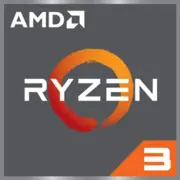AMD Ryzen 3 4300GE

AMD Ryzen 3 4300GE: Budget Processor for Compact Systems
Analysis of specifications, compatibility, and use cases
Key Features: Zen 2 Architecture and Energy Efficiency
The AMD Ryzen 3 4300GE processor, released in 2020, remains popular in the budget segment by 2025 due to its balance of price and performance. Its Zen 2 architecture and 7nm manufacturing process provide low power consumption (TDP of 35W) while delivering decent performance.
Key Specifications:
- 4 cores / 8 threads with frequencies of 3.5–4 GHz.
- 4MB L3 cache—sufficient for basic tasks but less than the higher Ryzen 5/7 models.
- Integrated Radeon Vega 6 graphics (operating frequency ~1700 MHz)—suitable for HD video and light gaming.
- Geekbench 6: 1472 (Single-Core), 5063 (Multi-Core)—results are close to Intel Core i3-10100, but with better energy efficiency.
Features:
- Support for PCIe 3.0 (16 lanes)—adequate for SSDs and entry-level discrete GPUs.
- Precision Boost 2 technology for automatic overclocking up to 4 GHz.
- Compatibility with the AM4 platform, which reduces upgrade costs.
Compatible Motherboards: AM4 Socket and Chipset Selection
The Ryzen 3 4300GE uses the AM4 socket, which is supported by most motherboards with A520, B550, X570 chipsets.
Recommendations:
- A520 (from $60): Budget option for office PCs. Example: ASUS Prime A520M-K.
- B550 (from $90): Optimal choice for upgrading (PCIe 4.0 support for SSDs). Example: MSI B550M PRO-VDH WiFi.
- X570 (from $150): Overkill for 4300GE, but relevant if planning to transition to Ryzen 7/9.
Important:
- Some B450/X470 boards require a BIOS update.
- Compact models in Micro-ATX or Mini-ITX format are suitable for mini-PCs (e.g., Gigabyte B550I AORUS PRO AX).
Supported Memory: DDR4 and Dual-Channel Mode
The processor works with DDR4 (up to 3200 MHz in OC mode). DDR5 support is absent, which is reasonable for the budget segment.
RAM Selection Tips:
- Use a dual-channel configuration (2×8GB) to improve iGPU performance.
- Optimal frequency is 3200 MHz (e.g., Kingston Fury Beast DDR4-3200).
- For office tasks, 8GB is sufficient, but 16GB is preferable for multitasking.
Power Supply: Minimum Cost
With a TDP of 35W, the Ryzen 3 4300GE does not require a powerful PSU.
Recommendations:
- 300–400W is adequate for systems without a discrete graphics card (example: be quiet! Pure Power 11 400W, $50).
- If planning to install a GPU (e.g., GTX 1650), choose a PSU rated at 450–550W (EVGA 500 BR, $45).
- For energy-efficient builds, power supplies with an 80+ Bronze certification are suitable.
Pros and Cons: Who Is It Relevant For in 2025?
Pros:
- Low power consumption—ideal for mini-PCs and HTPCs.
- Integrated graphics—does not require a separate graphics card for basic tasks.
- Affordable price (around $100–120 as of April 2025).
Cons:
- Only 4 cores—multithreaded tasks (rendering, streaming) are challenging.
- Lack of PCIe 4.0—high-end SSDs and GPUs won’t reach their full potential.
- Limited L3 cache—lags behind Ryzen 5 5500 (16MB) in gaming.
Use Cases: From Office to Home Theater
1. Office Tasks and Study
- Document work, browsing (20+ tabs), Zoom—processor handles it without lag.
2. Multimedia
- Streaming 4K video (Hardware Decode), editing in DaVinci Resolve (Full HD projects).
3. Gaming
- On iGPU: CS:GO (60 FPS on medium), GTA V (720p, low settings).
- With a discrete graphics card (GTX 1660): Fortnite (1080p, 60 FPS), but dips may occur due to 4 cores.
Comparison with Competitors: Ryzen 3 vs Intel Core i3
- AMD Ryzen 5 5600G ($140): 6 cores/12 threads, Vega 7. 30% faster in multitasking.
- Intel Core i3-12100 ($110): 4 cores/8 threads, UHD 730. Better in single-threaded tasks, but motherboards (LGA 1700) are more expensive.
- Ryzen 3 4300GE wins in price and energy efficiency but falls short in multithreaded workloads.
Practical Assembly Tips
1. Cooling
- The boxed Wraith Stealth cooler is adequate, but for quieter operation, choose the DeepCool GAMMAXX 400 V2 ($20).
2. Case
- Mini-PC: Cooler Master MasterBox Q300L (Micro-ATX).
- For upgrades: Fractal Design Define 7 Compact.
3. Storage
- An NVMe SSD (e.g., Kingston NV2 1 TB, $60) will speed up system boot times.
Final Conclusion: Who Is the Ryzen 3 4300GE Suitable For?
This processor is an excellent choice for:
- Budget PCs: If you need a computer for web browsing, office tasks, and Netflix for $300–400.
- Home Theater Systems: Low noise and 4K support.
- Office Solutions: Reliability and minimal power consumption.
However, for gaming or professional tasks (editing, 3D), it's best to add a discrete graphics card or opt for Ryzen 5. As of 2025, the 4300GE remains relevant as a "workhorse" for less demanding users.
Basic
CPU Specifications
Memory Specifications
GPU Specifications
Benchmarks
Compared to Other CPU
Share in social media
Or Link To Us
<a href="https://cputronic.com/cpu/amd-ryzen-3-4300ge" target="_blank">AMD Ryzen 3 4300GE</a>